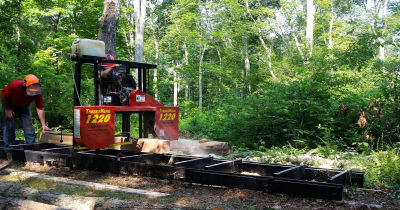
Connecticut has seen a tremendous increase in reforestation over the past century, with noticeable overgrowth and lack of management. The shrinking average parcel size of forested land in Connecticut calls for scale-appropriate management, but this is difficult with a high number of stakeholders. Even with increased roadside vegetation management and activities involving small-acreage treatments for wildlife habitats, people are generally reluctant to cut down trees. More diverse management options need to be made available to conserve working forests, which are forests managed without altering the ecosystem as a woodland. Sustainable harvesting can be a viable solution.
Portable band sawmills (fig.1) could help address this problem. Lumber is milled on-site, such as along roadsides, leaving woody debris behind, which can be beneficial to wildlife such as amphibians. Portable milling also decreases soil compaction and root damage, while removing fewer trees. Roadside trees have traditionally been avoided by sawyers, because the saw blade teeth can be ruined by cutting through nails on property signs or glass and metal left behind from automobile accidents. Occasionally, a sawyer is unable to mill a log due to this type of debris. Options such as metal detectors exist to determine the exact location of the metal and what portion of log should be removed before milling begins.

Like most portable band sawmill owners, my family uses one as a hobby (Fig. 2). Yet sawyers with entrepreneurial spirit who want to turn their hobby into a small business would like more support from the forestry community, such as finding a source for sustainably harvested logs. There is often a sentimental value attached to trees. I am very fond of a few trees in my own yard, and was saddened by the removal and disposal of a sugar maple a few years ago. Had I been able to use the wood from the tree to mill lumber and create something, it may have been easier to accept its removal as a necessary management tactic. If this option were offered more frequently, people might be more open to forest and roadside vegetation management.